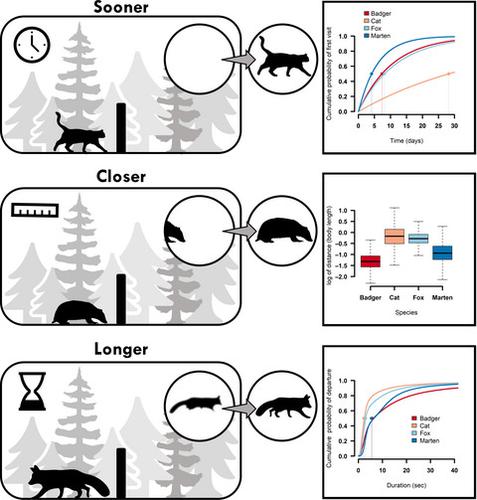Our official English website, www.x-mol.net, welcomes your
feedback! (Note: you will need to create a separate account there.)
Sooner, closer, or longer: detectability of mesocarnivores at camera traps
Journal of Zoology ( IF 1.9 ) Pub Date : 2020-09-01 , DOI: 10.1111/jzo.12828 M. Tourani 1 , E. N. Brøste 1 , S. Bakken 1 , J. Odden 2 , R. Bischof 1
Journal of Zoology ( IF 1.9 ) Pub Date : 2020-09-01 , DOI: 10.1111/jzo.12828 M. Tourani 1 , E. N. Brøste 1 , S. Bakken 1 , J. Odden 2 , R. Bischof 1
Affiliation

|
Camera trapping, paired with analytical methods for estimating species occurrence, population size or density, can yield information with direct consequences for wildlife management and conservation. Detectability, the ability to detect a species or individual if it is present, affects the reliability and efficiency of camera trap surveys and, in turn, varies across species, space and time. Greater detectability means greater sample size, and a common approach to boost detectability of wildlife by camera traps involves the application of olfactory lures. Using a camera trap study on sympatric mesocarnivores (European badger Meles meles, red fox Vulpes vulpes, pine marten Martes martes and domestic cat Felis catus), we quantified three elements of detectability: (1) the time until first detection (‘sooner’, conditional on being present), (2) the proximity to a focal point in front of the camera (‘closer’, conditional on being detected) and (3) the duration of exposure to the camera (‘longer’, conditional on being detected). A hierarchical analytical approach and a quasi-experimental setup allowed us to test for and quantify the species-specific effect of olfactory lures on these aspects of detectability. Depending on species, average median time to first detection ranged from 4 to 28 days, distance to the focal point from 0.3 to 0.8 body lengths, and median time to departure from 2 to 6 seconds. Credible intervals overlapped substantially between most species in all three measures, and variation between observations was extensive. We detected effects of lures on time to first detection for cats (castoreum; American beaver Castor canadensis scent), distance to focal point for badgers (striped skunk Mephitis mephitis scent) and martens (castoreum, fox and skunk scents), and the duration of exposure for foxes (fox and skunk scents). We discuss how a multifaceted perspective on detectability in camera trap studies, linked with species biology, can give investigators a more structured approach to selecting and testing measures intended to boost detection probability.
中文翻译:

更快、更近或更长:相机陷阱中中型食肉动物的可检测性
相机诱捕与估计物种出现、种群规模或密度的分析方法相结合,可以产生对野生动物管理和保护有直接影响的信息。可探测性,即检测存在的物种或个体的能力,会影响相机陷阱调查的可靠性和效率,进而会因物种、空间和时间而异。更高的可探测性意味着更大的样本量,通过相机陷阱提高野生动物可探测性的常用方法涉及应用嗅觉诱饵。使用对同域中食肉动物(欧洲獾 Meles meles、红狐 Vulpes vulpes、松貂 Martes martes 和家猫 Felis catus)的相机陷阱研究,我们量化了可检测性的三个要素:(1) 首次检测前的时间(“更快”以在场为条件),(2) 与相机前方焦点的接近程度(“更近”,以被检测为条件)和 (3) 暴露于相机的持续时间(“更长”,以被检测为条件)。分层分析方法和准实验设置使我们能够测试和量化嗅觉诱饵对这些可检测性方面的物种特异性影响。根据物种的不同,首次发现的平均中位时间为 4 至 28 天,与焦点的距离为 0.3 至 0.8 倍体长,中位时间为 2 至 6 秒。在所有三个测量中,大多数物种之间的可信区间大量重叠,并且观测值之间的差异很大。我们在第一次发现猫(海狸香;美国海狸 Castor canadensis 气味)时及时检测了诱饵的影响,獾(条纹臭鼬 Mephitis mephitis 气味)和貂(海狸香、狐狸和臭鼬气味)到焦点的距离,以及狐狸(狐狸和臭鼬气味)暴露的持续时间。我们讨论了与物种生物学相关的相机陷阱研究中可检测性的多方面视角如何为研究人员提供更结构化的方法来选择和测试旨在提高检测概率的措施。
更新日期:2020-09-01
中文翻译:

更快、更近或更长:相机陷阱中中型食肉动物的可检测性
相机诱捕与估计物种出现、种群规模或密度的分析方法相结合,可以产生对野生动物管理和保护有直接影响的信息。可探测性,即检测存在的物种或个体的能力,会影响相机陷阱调查的可靠性和效率,进而会因物种、空间和时间而异。更高的可探测性意味着更大的样本量,通过相机陷阱提高野生动物可探测性的常用方法涉及应用嗅觉诱饵。使用对同域中食肉动物(欧洲獾 Meles meles、红狐 Vulpes vulpes、松貂 Martes martes 和家猫 Felis catus)的相机陷阱研究,我们量化了可检测性的三个要素:(1) 首次检测前的时间(“更快”以在场为条件),(2) 与相机前方焦点的接近程度(“更近”,以被检测为条件)和 (3) 暴露于相机的持续时间(“更长”,以被检测为条件)。分层分析方法和准实验设置使我们能够测试和量化嗅觉诱饵对这些可检测性方面的物种特异性影响。根据物种的不同,首次发现的平均中位时间为 4 至 28 天,与焦点的距离为 0.3 至 0.8 倍体长,中位时间为 2 至 6 秒。在所有三个测量中,大多数物种之间的可信区间大量重叠,并且观测值之间的差异很大。我们在第一次发现猫(海狸香;美国海狸 Castor canadensis 气味)时及时检测了诱饵的影响,獾(条纹臭鼬 Mephitis mephitis 气味)和貂(海狸香、狐狸和臭鼬气味)到焦点的距离,以及狐狸(狐狸和臭鼬气味)暴露的持续时间。我们讨论了与物种生物学相关的相机陷阱研究中可检测性的多方面视角如何为研究人员提供更结构化的方法来选择和测试旨在提高检测概率的措施。











































 京公网安备 11010802027423号
京公网安备 11010802027423号